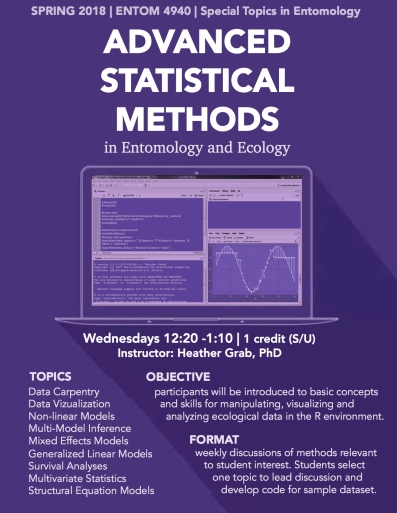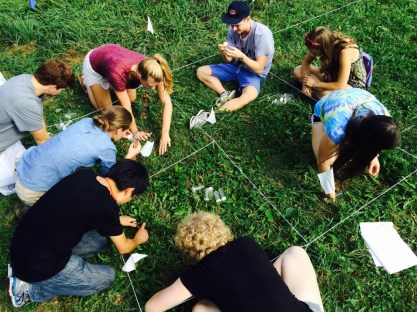My philosophy is drawn from my experiences as TA in courses ranging from Introductory Biology for freshman to advanced upper-level courses in Applied Statistics and Experimental Design. It is also inspired by the guest lectures and course modules I have developed for Insect Diversity and Evolution, Agroecology, Field Biology and from discussions with my peers and mentors through the Center for Teaching Excellence at Cornell.
Course Design

My approach to designing courses is based on the backward course design model and begins by identifying concrete learning objectives. The kinds of objectives can generally be divided between those that are topically driven or skills driven, and an individual course may combine both or focus more on one or the other. For example, in an Introductory Biology course the objectives are both skill based (micropipetting, etc) and topical (meiosis and mitosis, evolution) while in a Statistical Analysis and Experimental Design course the objectives are focused more on learning a specific skill which can be applied in a number of different fields.
I am most excited about teaching courses that include a novel research component. Rather than having a laboratory class repeat pre-designed experiments year after year, students should design their own research questions and experiments. There are a few reasons why I believe this approach is more engaging and effective for teaching science. First, these activities are much more flexible to student interests and second, because they require students to think about what might be a good research question, they engage the students more fully in thinking critically about the course material. Third, conducting a real experiment that hasn’t been tested ahead of time gives students a much more realistic idea of how science happens. And finally, by giving students an opportunity to contribute to a larger body of knowledge, they can connect more directly with the primary literature in a field.

Students assessing arthropod biodiversity and learning about species-area relationships in Field Biology
There are two ways which I plan to use this approach in my courses. The first is through a series of small short-term experiments done in groups that build on one another throughout the semester. Second, classes can be an ideal opportunity for collecting long-term ecological data and natural history data. I plan to use the first approach in an Introductory Biology course or in a Statistical Design course and the second approach in Entomology and Ecology courses.
In planning courses, I also follow the “flipped classroom” design principle. This approach was especially effective in the Applied Statistics course where students were assigned exercises in the statistics program R outside of class and then worked in groups at the board during class time to understand how the program arrived at an answer.
Take a look at an example Syllabus to see more about how I incorporate these approaches into my courses.
Assessment
Assessing student learning is an essential component of teaching. Assessments are not only important for providing students with feedback on their progress but also for monitoring the effectiveness of my own teaching practices. For this reason, I incorporate many opportunities for low-risk formative assessments such as iclicker questions, think-pair-share activities and short reading quizzes. Interspersed throughout my courses there are also longer form assignments. These assignments build up sequentially starting with an outline, then a draft for peer-reviews before a final manuscript is submitted. The majority of the written assignments in my courses are in the format of a scientific paper and effective peer-review is an essential component in the scientific process; therefore, I believe that teaching these skills will benefit not only my students writing but also their appreciation for the scientific process. Students in my courses are generally assigned multiple writing projects which are all graded with a similar Rubric. Although I am aware that many instructors tend to grade more strictly as the semester progresses, I grade with the same (high) level of expectations for each assignment in order that students can track their improvement throughout the course. However, I do increase the point value of each assignment such that early assignments do not have a disproportionately negative impact on a student’s overall grade.

Students in the Natural Resources’ Field Bio Insect Ecology Lab collecting grasshoppers for a mark-recapture study
To read more about my thoughts on student assessment please see my Teaching Statement.
Creating Effective Classrooms
 Feedback is essential in improving in any endeavor, especially in monitoring the quality of my own teaching. I use surveys in my teaching to gauge student interest and prior knowledge in a subject area and also to receive formal feedback on which aspects of my teaching and my courses are best received and which may need feedback. Because I believe that lasting learning is driven by intrinsic student interest, I use an entrance survey get a sense of the composition of the class and to better understand if there are certain topics that I should spend more or less time on. Mid-semester evaluations allow me to get a sense of how students feel the semester is progressing while there is still time to make changes. The mid-term course evaluation I developed for Applied Statistics and Experimental Design includes both questions with scaled responses as well as open-ended questions. Getting honest student feedback has been critical in improving my teaching approaches and it is important to me that I set aside time in class after an evaluation to let students know how I will make changes wherever possible based on their feedback.
Feedback is essential in improving in any endeavor, especially in monitoring the quality of my own teaching. I use surveys in my teaching to gauge student interest and prior knowledge in a subject area and also to receive formal feedback on which aspects of my teaching and my courses are best received and which may need feedback. Because I believe that lasting learning is driven by intrinsic student interest, I use an entrance survey get a sense of the composition of the class and to better understand if there are certain topics that I should spend more or less time on. Mid-semester evaluations allow me to get a sense of how students feel the semester is progressing while there is still time to make changes. The mid-term course evaluation I developed for Applied Statistics and Experimental Design includes both questions with scaled responses as well as open-ended questions. Getting honest student feedback has been critical in improving my teaching approaches and it is important to me that I set aside time in class after an evaluation to let students know how I will make changes wherever possible based on their feedback.
Read a some of the feedback students have given me here.
Professional Development
Teaching is an art but also a science. Research on teaching has revealed new strategies that improve student engagement and comprehension and by staying informed of these advances I will maintain my effectiveness throughout my career.
To read more about my thoughts on teaching please see my Teaching Statement.